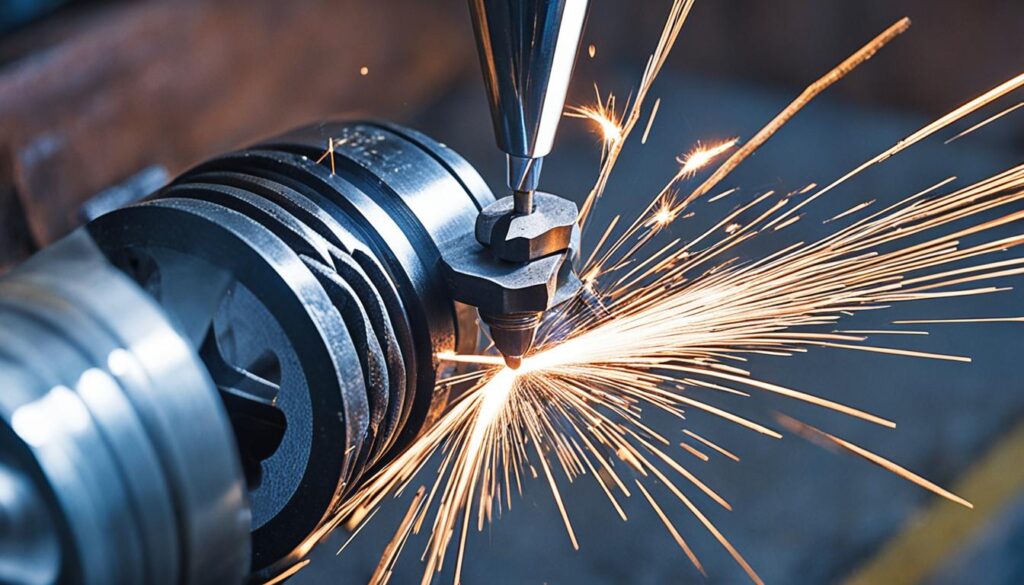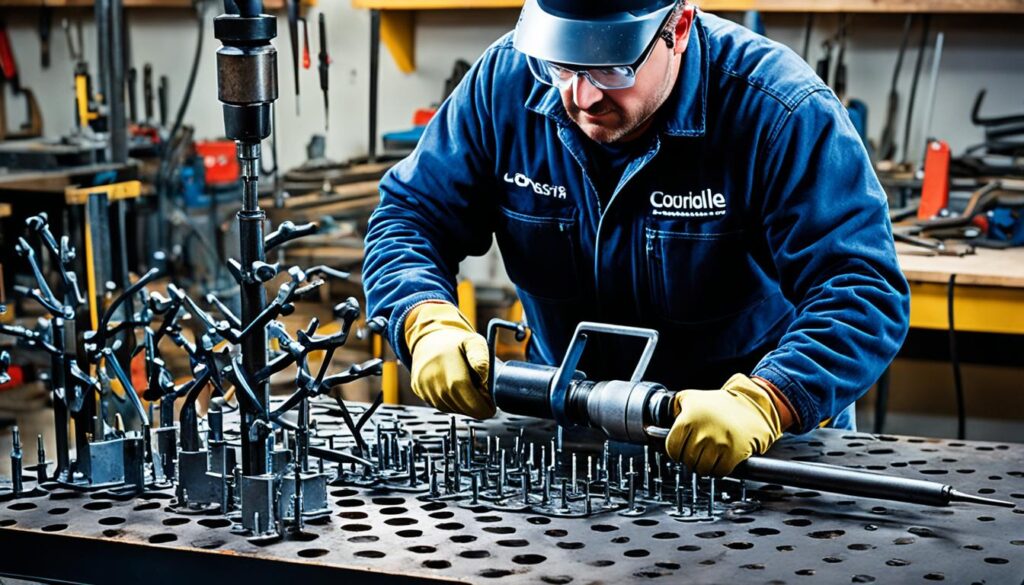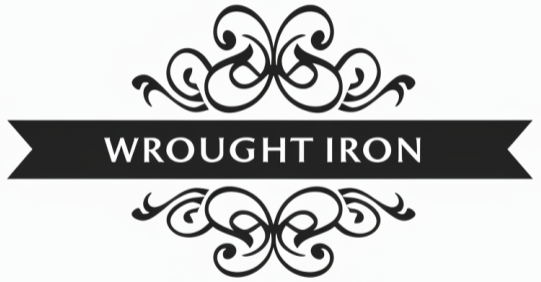
Ever felt excited about starting a DIY project, but then worried about drilling through wrought iron? Many of us face this challenge, whether we’re experienced metalworkers or homeowners wanting to improve our spaces. The feeling of success when your drill goes through metal is unmatched. It’s definitely worth the effort.
Imagine you’re in your workshop, the air smells of metal, and your drill is buzzing. The wrought iron in front of you looks beautiful but seems tough. You’ll need the right tools, techniques, and safety steps to get through it. Let’s explore the key tips for drilling through wrought iron that will make your project easier and more fulfilling.
Key Takeaways
- Safety First: Always wear safety glasses that wrap around your face to protect from flying metal fragments1.
- Use the Right Drill Bits: High-speed steel (HSS) bits are good, while cobalt or black oxide bits last longer for harder metals2.
- Lubrication Matters: Use cutting fluid or multipurpose oil like 3-IN-ONE when drilling thick wrought iron to make the bits last longer1.
- Slow and Steady: Drilling slowly helps avoid overheating and dulling the drill bits13.
- Stability is Key: Always clamp your workpiece to prevent accidents and ensure you’re drilling accurately.
- Pre-drill for Accuracy: Using a center punch to make a dimple helps guide your drill and keeps it straight3.
- Consider a Drill Press: These machines give you more accuracy and might be a good investment13.
Can You Drill Through Wrought Iron?
Drilling through wrought iron is possible with the right tools and techniques. It’s a tough material that needs a careful and slow approach.
Understanding Wrought Iron
Wrought iron is known for its strength and flexibility. It’s often used in building and decoration. You’ll need the right tools and a careful plan to work with it.
Choosing the Right Tools
Choosing the best drill for wrought iron is key. For most metal drilling, high-speed steel (HSS) bits work well. But for harder jobs, black oxide or cobalt steel bits are better because they last longer and handle heat better1. Drill bits with a titanium nitride (TiN) coating also last a long time, up to six times longer than HSS bits1.
Drill Bits for Wrought Iron
For drilling wrought iron, focus on quality and sharpness in drill bits. This makes drilling smoother and helps the bits last longer. Using cutting fluid or oil on the bits also reduces heat and friction, making them last even longer1.
Here are some recommended drill bit types:
- High-speed steel (HSS) bits for general tasks1
- Black oxide or cobalt steel bits for harder metals1
- Titanium nitride (TiN) coated bits for extended longevity1
Drilling at a slow speed helps prevent the bits from getting dull quickly. It also makes for cleaner holes. Using a drill press can be more precise and efficient than a handheld drill1.
| Drill Bit Type | Best For | Lifespan |
|---|---|---|
| HSS | General metal tasks | Standard |
| Black oxide/Cobalt steel | Hard metals like stainless steel | Longer |
| Titanium Nitride (TiN) | Extended durability needs | Up to 6 times longer than HSS |
Preparing Your Work Area
When drilling wrought iron furniture or railings, a well-prepared work area is key. Make sure the metal is clamped down to prevent accidents and ensure accuracy. It’s best to use at least two clamps to keep the metal steady4
To protect your work surface, place scrap wood under the hole saw’s pilot bit. This method helps make clean cuts without damaging your workbench. Marking the drilling spot and using a center punch for a precise start is also helpful4. This is crucial when working with wrought iron of different thicknesses, as it affects the drilling process5.
Think about the cost of quality control in your work area, especially if parts come from various suppliers. Using parts from different foundries can affect how easy they are to drill and their hardness5. This is important for a cost-effective and efficient setup when drilling wrought iron.
Using a magnetic base drill with carbide bits or a solid carbide drill can be a big help. These tools are great for tackling hard parts6. They improve both the precision and safety of your work area, making it ready for the task.
Getting your area ready well not only boosts your safety but also your efficiency. It’s essential whether you’re drilling wrought iron furniture or railings.
Proper Drilling Techniques for Wrought Iron
When working with wrought iron, getting the drilling right is key. You need to use lubricants, apply the right pressure, and adjust for the iron’s thickness.
Using Lubricants to Reduce Friction
It’s vital to lubricate your drill bit to cut down on friction and prevent it from overheating, especially when drilling wrought iron gates. Using the right lubricants keeps the drill bit cool and reduces wear. This is crucial for materials like steel that are at least 1/8 inch thick7. This method also makes your drill bits last longer, making your drilling process more efficient1.
Applying the Right Pressure
Getting the pressure right when drilling is key. Too much can break the drill bit, while too little won’t get the job done. Start slow when drilling wrought iron gates and gradually increase the pressure until the drill bit goes through smoothly. Cobalt (HSS-Co) drill bits work well because they resist heat and wear7. A step drill bit is also useful for making precise holes of different sizes1.
Handling Thin vs. Thick Pieces
Drilling thin and thick wrought iron needs different strategies. For thin pieces, use a wood sandwich to keep the iron steady and prevent the drill from slipping. For thicker iron, start with a small hole and gradually increase the size. This method helps avoid overheating and makes for cleaner holes. Drilling at a lower speed for larger bits on hard metals helps control heat and ensures accuracy3.
Safety Tips for Drilling Through Wrought Iron
Drilling through wrought iron requires careful safety steps. Here are key tips to keep you safe and injury-free.
Eye and Hand Protection
Protecting your eyes and hands is crucial when working with wrought iron. Always wear eye and hand protection. Safety glasses with side shields shield your eyes from flying metal pieces that could hurt you badly8. Heavy leather work gloves also protect your hands from sharp edges and cuts89. Be extra careful when the drill breaks through the metal, as the high speed can make the metal resist strongly9.

Stabilizing Your Workpiece
Keeping your workpiece steady is a key safety rule for wrought iron drilling safety. Make sure it’s clamped down well to stop it from moving during drilling. This makes your drilling more precise and safer8. It also lowers the chance of the metal spinning or flying off, which could hurt you badly8. Using the right techniques to keep things stable makes drilling safer and more controlled.
| Drilling Safety Tips | Benefits |
|---|---|
| Wear safety glasses | Protects eyes from metal fragments |
| Use heavy leather gloves | Prevents cuts and injuries |
| Secure clamping | Prevents workpiece from spinning |
Conclusion
Drilling through wrought iron can be tough but doable with the right tools and methods. Choosing the right drill bit is key, like using carbide-tipped masonry bits with an 80-degree tip for angle iron10. Also, using lubricants like oil or cutting fluid helps reduce friction and makes your drill bit last longer10. When drilling wrought iron railings, control your speed and pressure for the best results.
Safety is crucial when working on these projects. Wear safety glasses, heavy gloves, and long sleeves to protect against metal shavings11. Using vices to hold your work in place helps make clean holes11. This is especially important for thin and thick pieces to prevent accidents.
With these tips, you can tackle your wrought iron projects confidently. Whether it’s for home improvements or custom furniture, careful planning helps you do a great job. Marking where you’ll drill first helps avoid mistakes and makes the process smoother11. Always focus on safety and technique for successful and safe drilling. Happy drilling!
FAQ
Can you drill through wrought iron?
What is the best drill for drilling through wrought iron?
What type of drill bits should I use for drilling wrought iron?
How do I prepare my work area for drilling wrought iron furniture or railings?
What are some essential tips for drilling wrought iron gates?
How can I ensure safety when drilling through wrought iron?
What are some effective techniques for drilling through wrought iron?
Source Links
- 12 Tips for Drilling Holes in Metal – https://www.familyhandyman.com/list/tips-for-drilling-holes-in-metal/
- How to Drill through Metal: 10 Tips and Techniques – https://www.wikihow.com/Drill-Metal
- A Step-by-Step Guide to Drilling Holes in Metal | Clickmetal – https://www.clickmetal.co.uk/blog/post/a-step-by-step-guide-to-drilling-holes-in-metal
- How to Drill a Hole Through Metal | Tractor Supply Co. – https://www.tractorsupply.com/tsc/cms/life-out-here/tool-shop/tool-tips/how-to-safely-drill-metal
- Drilling holes in HARD cast iron – https://www.practicalmachinist.com/forum/threads/drilling-holes-in-hard-cast-iron.211580/
- How do you drill an un-drillable hole ???? – https://www.mtfca.com/phpBB3/viewtopic.php?t=1868
- Tivoly France – https://www.tivoly.com/en/tips-drill-metal-stainless-aluminum-cast-iron-steel
- Best Techniques for Drilling Through Metal | Hunker – https://www.hunker.com/13715922/how-to-drill-through-metal
- Drilling metal correctly | Jungheinrich PROFISHOP – https://www.jungheinrich-profishop.co.uk/en/profi-guide/metal-drilling/
- How to Drill Through Angle Iron? The Ultimate Guide – https://www.metalready.com/news/how-to-drill-through-angle-iron/
- Can You Drill Into Cast Iron? – https://www.castironwelding.co.uk/blog/can-you-drill-into-cast-iron/




